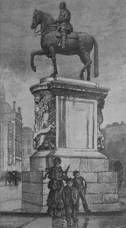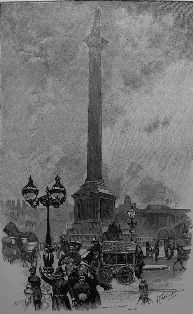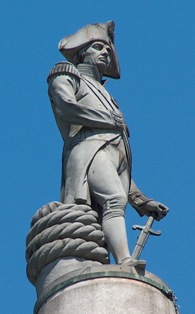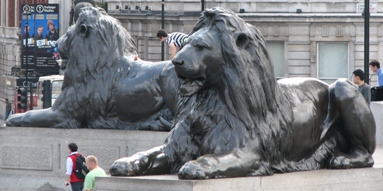Sculpture at Trafalgar Square
 Charles 1 at Charing Cross, St Martins behind
Charles 1 at Charing Cross, St Martins behind
Trafalgar Square, on the doorstep of the National Gallery, must be the most popular place to see sculpture outdoors in London. The main attraction, the statue of Lord Nelson, is best appreciated from a distance, being 170 ft up in the air. The 17ft high statue is by E. H. Baily, and the column designed by William Railton. It was erected in 1839/43. More pictures on this page. The impressively sized reliefs on the base of the column, which can be scrutinised in detail, are by Ternouth, Woodington, Watson and Carew. The enormous lions - see bottom of this page - are by Landseer, the animal painter (more pictures of these sculptures are on this page); this site describes a range of other lion statues on this page. (By comparison, the Liverpool Nelson monument is described in some detail on this page.)
Of the other statuary, the most important is the equestrian Monument to Charles I, made by Hubert le Sueur in 1633, who sits on a traffic island. Several views of this statue are on the horse statues for drawing page. There are four great pedestals around the square, one of which used to be empty and has been the subject of much debate as to what should be put there - a series of modern works has occupied the spot, of which the one by Turrell was by far the best, and at least from the emails sent to this site, the most popular. I think it jarred with the architecture here, and should be placed in a different site, but having seen the various things which have replaced it, I would welcome its return. Come back Mr Turrell, all is forgiven.
Of the permanently inhabited pedestals, another equestrian statue occupies one - George IV by Chantrey and T. Earle. The horse is especially good and the statue is considered one of Chantrey's finest. This statue, costing 9000 guineas, was originally for the Marble Arch and arrived in Trafalgar Square in the 1840s. The other two sites support Havelock, by Behnes (1861), and Napier, by G. G. Adams (1855), the latter with a good hooked nose. But Napier in particular was sneered at on every possible occasion. An example:
One trembles to think how certain hideous statues, such as the Napier in Trafalgar Square, would shock the public eye if their kindly black shroud were suddenly removed [by cleaning]. - Magazine of Art
In front of the National Gallery are three smaller statues - one is James II attributed to the studio of Grinling Gibbons and dates from 1686. On the front of the east facade of the building is a Flaxman statue of Minerva - this was also originally intended for the Marble Arch. Finally, the fountains (an afterthought to the Square by Charles Barry in 1845) have lively mermen and mermaids of a much later date (1939) by Charles Wheeler and W. McMillan respectively. Note the little toothy sharks swimming next to the dolphins. Also by Wheeler and McMillan are the three head-and-chest portrait statues against the north 'wall' of the Square: generals Beatty, Jellicoe and Cunningham.
So much for the statues. A few words on the architecture. The square is on a slope, and the original square of Nash (1820s) was remodelled by Charles Barry in 1840 by forming the northern terrace and putting in the steps. Apparently the fountains were remodelled after the First World War by Lutyens, to commemorate Beatty and Jellicoe. The main building is the National Gallery, by William Wilkins (1832-8). It has been generally regarded with dissatisfaction, and Pevsner notes that it does not really have the stature to dominate the upper part of the Square as it ought. Leighton was one of many who complained about the extensions:
The original building has remained unaltered as to its exterior; but on the rear of one of its flanks loom now into view, first an appendage in an entirely different style of architecture, and further on, an excrescence of no style of architecture at all: the one an Italian tower; the other a flat cone of glass surmounted by a ventilator - the whole resulting in a jarring jumble and an aspect of chaotic incongruity, which would be ludicrous if it were not distressing. - Lord Leighton PRA
The corner of the square on the right as we regard the National Gallery is the iconic St Martins in the Fields, the principal work of the architect James Gibbs. In one of the galleries of its recently much-enlarged crypt it contains a collection of monuments, some of which have sculptural interest.
Among the other buildings round the square, Canada House, the former Royal College of Physicians, dating from 1824-7, has some rather splendid Ionic columns - the favoured Greek order of the architect, Robert Smirke, who also designed the British Museum - it is described on the Cockspur Street page. Admiralty Arch (1911) by Aston Webb, at the entrance to The Mall is part of the National Monument to Queen Victoria. South Africa House (1935) has interesting bits of sculpture all over - high up on one corner is a carved figure of Dias, which is best seen from the other side of the road. The extension to the National Gallery (the Sainsbury Wing) is a remarkably restrained modern addition which is to be commended.
One minute's walk away is the site of Charing Cross itself, and a sculptural walk down the Strand, while Charing Cross Road leads north from the Square.
West along Cockspur Street // The Mall (south and westwards) // Whitehall (southwards) // East to Charing Cross //
and the Strand // St Martins in the Fields Church // Charing Cross Road to the North

 Nelson's column, and Nelson.
Nelson's column, and Nelson. Two of Landseer's lions.
Two of Landseer's lions.